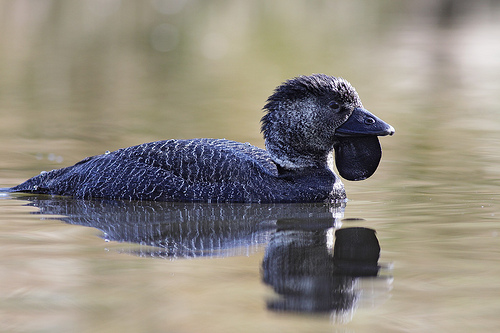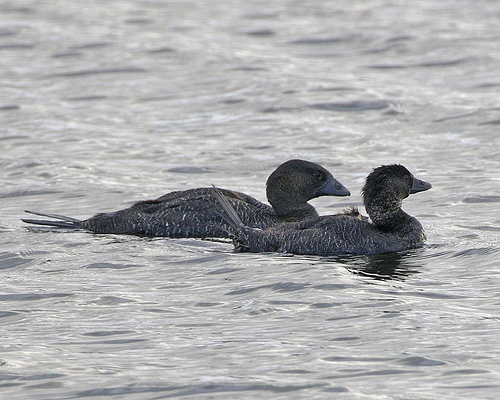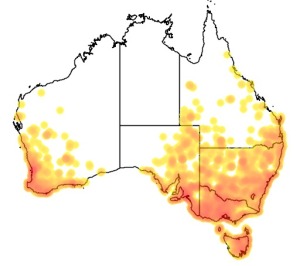Colours
Distinguishing features
Adult males have a distinctive large, leathery lobe underneath the bill; females are unadorned. Their drab dark grey-brown, sightly pin-striped plumage is unconspicuous and does not differ between the sexes. Musk Ducks float very low in the water, almost like a cormorant, and the large webbed feet are well back on the body. The ducklings are covered in dark brown down.
In its native range, the fanned tail is distinctive, allowing to distinguish this species from the Freckled Duck (Stictonetta naevosa) which has similar size, coloration and habits. The Blue-billed Duck (Oxyura australis) has a similarly shaped tail but the main colour of its males in breeding plumage is a much richer chestnut brown.
Females and males in nonbreeding plumage are very similar however and if one is not intimately familiar with the slight differences in behavior, they cannot be told apart from female Musk Ducks at a distance. Male Musk Ducks in the breeding season are usually unmistakable due to the large bill lobe. (Wikipedia)
Size
- From 60 cm to 70 cm (Length of specimen) - applies to Males
- From 47 cm to 55 cm (Length of specimen) - applies to Females
Wingspan
- Wingspan data is not yet available.
Synonyms
Distribution
Distribution and habitat preferences
They are native to southern Australia. Musk Ducks are moderately common through the Murray-Darling and Cooper Creek basins, and in the wetter, fertile areas in the south of the continent: the south-west corner of Western Australia, Victoria, and Tasmania. Musk Ducks avoid the far north, the arid west and north-west.
This species prefers deep, still lakes and wetlands with areas of both open water and reed beds. They seldom emerge from the water and are awkward on dry land. They rarely fly: take off is made with difficulty, and landing is a clumsy, low-angled affair with no attempt to lower the feet. However, at need Musk Ducks fly swiftly and for long distances, with rapid, shallow wing beats.
In the water, Musk Ducks display an effortless agility, twisting and turning on the surface with both feet and tail. In general, Musk Ducks remain in the water all day long, alternately loafing and feeding energetically, though they sometimes emerge to sit on a log or on dry land for a while. They stay on the water at night, sleeping well out from land with the head tucked into the body or under a wing. (Wikipedia)
Diet
The primary diet items are water beetles, yabbies, water snails, freshwater shellfish, and the like, supplemented with a variety of aquatic plants and a few fish. (Wikipedia)


